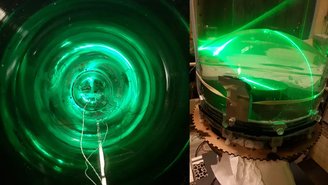In a recent study, a group of researchers led by Professor Alban Pothérat from Coventry University in the United Kingdom developed an experimental device. Mimicking how Earth’s magnetic field works may be affecting planetary flow patterns.
The authors realized that existing models describing our planet’s internal flows generally do not explain how the magnetic field affects the flows in which it is generated. In this way, its innovative approach aims to accurately imitate the functioning of the Earth’s internal mechanism.
What is known so far is that there is a solid core at the center of our planet, resembling a ball of hot metal. It is so hot that it has a liquid outer core of molten metal around it and under the mantle. As the two rotate, the result is an electric current. In the formation of the magnetic field that protects us against harmful radiation from the Sun.
Imitating the liquid metal flow of the outer core
Although the nucleus is very complex, there is a principle in dynamics called the Taylor-Proudman Theorem that is valid for all fluids rotating around an axis. Its basic principle is that when a fluid circulates at constant angular velocity, its motion is limited to planes perpendicular to the axis of rotation.
It is as if the liquid was moving “in slices” or layers rather than moving freely in all directions. In this case, Pothérat explains to IFLScience: “What we need to do is put a model of the Earth filled with sulfuric acid inside this giant magnet and shine a laser on it and make some measurements.”
One effect that cannot be measured in this model but must be considered is the Coriolis force, an important phenomenon related to the Earth’s rotation. acting on any object (or liquid) moving relative to the Earth’s surface, deflects fluid objects To the right in the Northern Hemisphere, to the left in the Southern Hemisphere.
How does the earth’s magnetic field simulator work?

In creating a basic model device to represent Earth, the team used a tank partially filled with a 30% concentration of sulfuric acid placed in a strong magnetic field created by a giant magnet at the Grenoble High Magnetic Field Laboratory in France. Measurements were taken with a laser.
To replicate real-world conditions as faithfully as possible, the researchers heated the tank from the center. They also gave the upper hemisphere a flat bottom and placed a tank filled with water there to provide a cooling effect. To finish, they placed small pieces of glass into liquids to direct the laser through it.
Conclusions on the dynamics of the Earth’s magnetic field

The result of the experiment surprised the researchers, according to Potherat, because although the flow moved in the rotational direction as expected, “we saw that the liquid went in at the top of the cylinder and came out at the bottom. This is interesting because when you stir the tea, it moves in the opposite direction.” This shows that magnetic field directs the flow in a controlled and defined manner.
The authors suggest that this “cylinder” is crucial in generating the Earth’s magnetic field. In other words, the behavior of molten metal within the core not only affects the strength and direction of the magnetic field, but is also an important part of the process that keeps it active over time.
Follow the latest studies on the geology of planet Earth at TecMundo and get the opportunity to share the article with your friends on social media. Until later!
Source: Tec Mundo
I’m Blaine Morgan, an experienced journalist and writer with over 8 years of experience in the tech industry. My expertise lies in writing about technology news and trends, covering everything from cutting-edge gadgets to emerging software developments. I’ve written for several leading publications including Gadget Onus where I am an author.












